The anarchic spirit of Julia Ducournau’s Palme d’Or winner Titane lives on in Emma Benestan’s Critics Week closer Animale, the genre-busting debut of a director who cites Buffy the Vampire Slayer, Kathryn Bigelow’s Near Dark, and the naturalist films of Chloé Zhao as influences. More surprisingly, she also credits Abdellatif Kechiche, since her first break was as assistant editor on his 2013 Palme d’Or winner Blue Is the Warmest Colour.
Emma Benestan
Pascal Le Segretain/Getty Images
Benestan — who would later take a full-blown editor credit on his 2017 feature Mektoub, My Love — was then finishing her studies at France’s prestigious La Fémis film school, but observing Kechiche’s directorial style, and witnessing his penchant for mixing professional and amateur actors, was an education in itself. “It’s the way he marries professionals and amateurs that gives his films a certain spontaneity,” she explains. “I’d been taught the director had to control everything, but directing isn’t only about control. I learned that from Abdel — directing is also about letting things happen.”
Set against the bull-fighting scene of the Camargue region in southern France, Animale stars Divines breakout Oulaya Amamra as Nejma, a 22-year-old woman who is trying to make her way in the male-dominated world of bullfighting. She appears to have been accepted by the group, but after a night of hard drinking with the boys she wakes up with a sense that something is wrong. Shortly after, news breaks of a rogue bull on the loose. Young men are found dead, and Nejma starts to experience some strange bodily changes…

Read the digital edition of Deadline’s Disruptors/Cannes magazine here.
Benestan has long been fascinated by the Camargue people’s passion for the long-horned, black bulls that run semi-wild across its wetlands. “I grew up not far from the Camargue,” she says. “When I was young, we’d go to the races. The culture of the bull was everywhere. My adolescence is bathed in it.” Accompanying her for this adventure was Ruben Impens, cinematographer on Titane and Ducornau’s previous film, Raw (“I think he, too, was fascinated by this magical world”). Together, they faced the film’s biggest challenge: capturing the bulls on camera: “You never know exactly what they’re going to do,” she says. “We had to work with the unexpected.”

